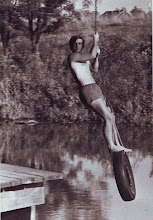First, let me introduce Tom Grunwald, fourth form head and most interesting member of the Sayre School faculty, hereafter affectionately referred to as Gruner. I have also referred to TGP in an earlier post, and will frequently in the future. TGP is "The Great Pha". Pha is Father and the somewhat self-chosen moniker came about somewhere late in high school, during the trip he chaperoned to Williamsburg.
Anyway, on with the story. As part of American History in ninth grade, Gruner wanted us to understand what it took to create a bow and arrow. Actually, he was willing to provide the arrow; we just had to create the bow.
Living in the country, you would think that it wouldn't be too hard to find a suitable piece of pliable wood. Wikipedia says: "Find a piece of dry, dead but not gray and cracking hardwood--oak, hickory, yew, black locust, or teak" Honestly, I don't even remember the search across our acreage for the bow wood. We had birch and a few other types of trees, but Uncle Hall mowed just often enough that there wasn't a lot of dead wood anywhere on the property. I eventually found some piece of wood that I thought would be suitable and brought it home. I worked and worked at bending that wood so I could string the bow. It didn't bend much.
I do clearly remember that after my stringing effort failed, TGP came to the rescue. He promptly pulled and pulled and finally broke the bow that I had found. It was late and it was dark, so we shifted to the next obvious choice, a broom handle. Recall the Wiki article and the fact that there was no mention of broom handles. Think logically about what you want a broom to do (not bend) and contemplate what comes next. TGP said "Oh, it will be fine" with enough authority to inspire whittling. Amazingly enough, whittling was followed by an exceptionally long time in the bathroom with the shower on hot for steam. A 40 gallon hot water heater will only produce steam for so long (check with 19 y.o. Caroline for exactly how long), but that process was repeated for multiple cycles. Thankfully the Tankless Water Heater had not yet been invented. I'm surprised that my bathroom wallpaper even survived the night.
Very late that night I had, essentially, a tapered broomstick with a bow string that literally touched the bow for the length of it. Not any bend at all.
Now, being a straight A student, I was nervous going into class with my sorry bow. Gruner took one look at the contrivance and said, "Oh, it will be fine". Perhaps an interesting trait of Kentucky men, or just an interesting coincidence between Pha and my history teacher. We went from Old Sayre to the parking lot behind the gym. Several bows were demonstrated with real arrows and pullable strings. Gruner took what I brought from home and worked at stringing it. He just wanted to force a little bend in it.
Of course, Gruner broke the broom handle bow trying to string it there in the parking lot. I don't know what grade I got on that project, but it was not a high point of my academic career. It's not clear what we learned about native Americans, except that I bet they were better at making a bow than this ninth grader at Sayre. But I do laugh when I remember the story. And I love having grown up trying to make things out of orange juice cans and bailing wire.
Mischief in Ministry-Weddings, Funerals, and Other Accidents of Grace
-
Near our home was a pretty substantial piece of property we called “Bloom’s
Pond.” The Bloom family lived in the house on the property which had what
to a ...
3 days ago


2 comments:
Great chuckle. What about the needle noes plyers and the toenail?
was a formative event in someone else's life. If you'll remember, the girls had to bake bread for this assignment. And, this was before bread machines, mind you. This particular separation of duties would smack of sexism in today's classroom, but of course reflected the roles of the time. Only at Sayre could authenticity reign!! And to this day, when the crossword calls for the species of wood used in bows, by golly, I know it!!
Post a Comment